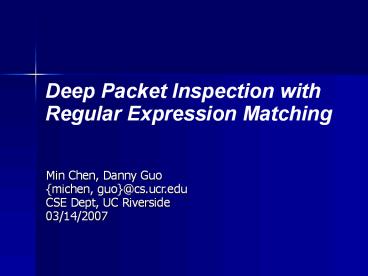Deep Packet Inspection with - PowerPoint PPT Presentation
Title:
Deep Packet Inspection with
Description:
Operates at wire speed. Large number of signatures (i.e. string patterns) ... Higher processing speed ... For speed test: '[1-9]* [0-9].*[0-9] ... – PowerPoint PPT presentation
Number of Views:1047
Avg rating:3.0/5.0
Title: Deep Packet Inspection with
1
Deep Packet Inspection with Regular Expression
Matching
Min Chen, Danny Guo michen, guo_at_cs.ucr.edu CSE
Dept, UC Riverside 03/14/2007
2
Outline
- Motivation
- Background and challenges
- Evaluation metrics
- Algorithm comparison
- Implementation details
- Regular expression
- DFA NFA
- Detection engine
- Result
- Future work
3
Motivation
- A class of packet processing applications need to
inspect packets deeper than the protocol headers
and analyze its payload - Network Security
- HTTP load balancing
- XML processing
- Content-based billing and forwarding
4
Deep Packet Inspection (DPI)
- Shallow packet inspection
- Checks the header portion of a packet only
- Deep packet inspection
- A form of computer network packet filtering that
examines the data part of a through-passing
packet, searching for non-protocol compliance or
predefined criteria to decide if the packet can
pass
5
Challenges for DPI
- Operates at wire speed
- Large number of signatures (i.e. string patterns)
- Patterns highly complex and have overlaps
- Location of signatures is unknown
6
DPI Evaluation Metrics
- Packet processing rate
- Memory requirement
- SRAM, DRAM, TCAM
- Power consumption
- TCAM
- Scalability
- The time to process new signatures and insert
them into the system
7
DPI Algorithms
- Fixed string matching
- Parallel Boyer-Moore (BM)
- Aho-Corasick Boyer-Moore (AC_BM)
- Setwise Boyer-Moore-Horspool
- Bloom Filter
- CAM Based
- Regular expression matching
- Deterministic Finite Automation (DFA)
- Non-deterministic Finite Automation (NFA)
8
Regular Expression (RE)
- Expressive power and flexibility for describing
useful patterns - Linux Application Protocol Classifier
- (L7-filter)
- the Snort intrusion detection system (1131 out of
4867 rules using regular expressions as of
February 2006)
9
Example of RE
- (ymsgypnsyhoo).?.?.?.?.?.?.?lwt.\xc0\x80
10
DFA Vs. NFA
- Performance comparison
- For 1 RE with length n
- DFA
- Higher processing speed
- Acceptable construction time and memory
consumption with lazy-DFA (DFANFA) - More efficient in software implementation
11
Project Architecture
12
Detection Engine
RE1 DFA
RE2 DFA
Input buffer
RE3 DFA
RE8 DFA
Content Scanner 1
outgoing Streams
Incoming Streams
Content Scanner 2
Dispatcher
Content Scanner 16
13
Detection Engine Setup
- of Content Scanner (optimal)
- SRAM 128bits (input)
- Processing unit 8bits/char
- Processing power 128/8 16 chars/cycle
- of REs for each Content Scanner
- SRAM 128bits (output)
- Processing unit 1bit (accept1 else0)
- of streams 16 (best throughput)
- Each stream could be processed with 128/168 REs
concurrently
14
DFA Representation
15
Environment on Grep application
- Input stream 70MB file
- RE
- For speed test 1-9 0-9\.0-9
- For area test U\.?S\.?(D\.?)?\ (\\
)?(0-9,0-9,0-90-9\.0-9\.0-9
0-9(\.0-9)?\ milli?on)
16
Result
- Optimal throughput
- 16 8bits 200MHz 25.6Gbps
- Processing speedup
- Logic consumption
- 9 Slice Flip-fllop
- 6 4-input LUT
17
Future work
- SNORT
- More powerful application
- Input stream preprocessing
- TCP/IP packet
- Packet arrival interval latency
18
- Special thanks to John and Betul for the
instruction on ISE and ROCCC































